- Magazine Subscription Offer
- Newsletters
- Competitions
- Holiday ideas
- Wildlife stories
- Marine life
- Insects and invertebrates
- Trees and plants
- Farm animals
- Experiences
- Historical figures
- Green living
- Food & recipes
- Foraging guides
- Outdoor skills
- Craft ideas
- Photography
- Latest issue
- Meet the team
- Countryfile TV guide
- Countryfile presenters
- Countryfile calendar

Forclaz 10w portable solar charger review
A lightweight solar panel for charging mobile devices when you're out walking or camping. Plus we look at power banks for storing solar power
Fergus Collins
Easy to use Works in overcast conditions (though slowly) Provides plenty of power over the course of a day Good value
Will not always charge a phone directly – hence the need for a power bank
Increasingly smart phones are the walker’s and camper’s friend. With a great camera, online mapping and gps locators, compass and, of course, a phone… The drawback is of course battery life and one of the stresses of camping in particular is trying to eke out battery life. It’s hard to find a plug socket at the bottom of a hedgerow.
Now imagine a lightweight, energy source that provides a decent charge for free that you can pop in your backpack. A portable solar panel could be the mini power station to transform your days out.
The Forclaz panel has a single hinge and opens to offer a large area to capture sunlight. There are loops for you to connect the panel to the outside of a backpack, a tent or other suitable support. Or you can lean it at an angle. It is waterproof in light showers.
On the back it has a net pocket to hold a battery and an energy transformer so you can plug a USB cable. With 10W of power, in full sunlight it can charge a considerable amount of battery over a sunny day . Even in overcast conditions, the panel gathered an impressive amount of energy.
While the panel will charge a phone directly, it can be inefficient as many phones don’t like the intermittent nature of solar power. When it clouds over, the power drops and the phone may simply refuse to charge. Instead, I use the solar panel to charge a portable charger known as a power bank. Mine is a PowerAdd, which holds 20000 mAH, enough to charge my Android phone four times.
I’ve estimated the Forclaz panel can charge up half of the battery over a day in the sun, (which is two full phone charges). Using these devices, I haven't charged my phone from the mains for six months though I haven't calculated the cost savings involved.
What is mAH?
This is milliampere/per hour – a measurement of how much charge a battery can hold. For example, a good AA battery can hold 1500 mAH.
Forclaz Solar Panel
- Buy the Forclaz Solar Panel from Decathlon
PowerAdd Power Bank
Also consider:.
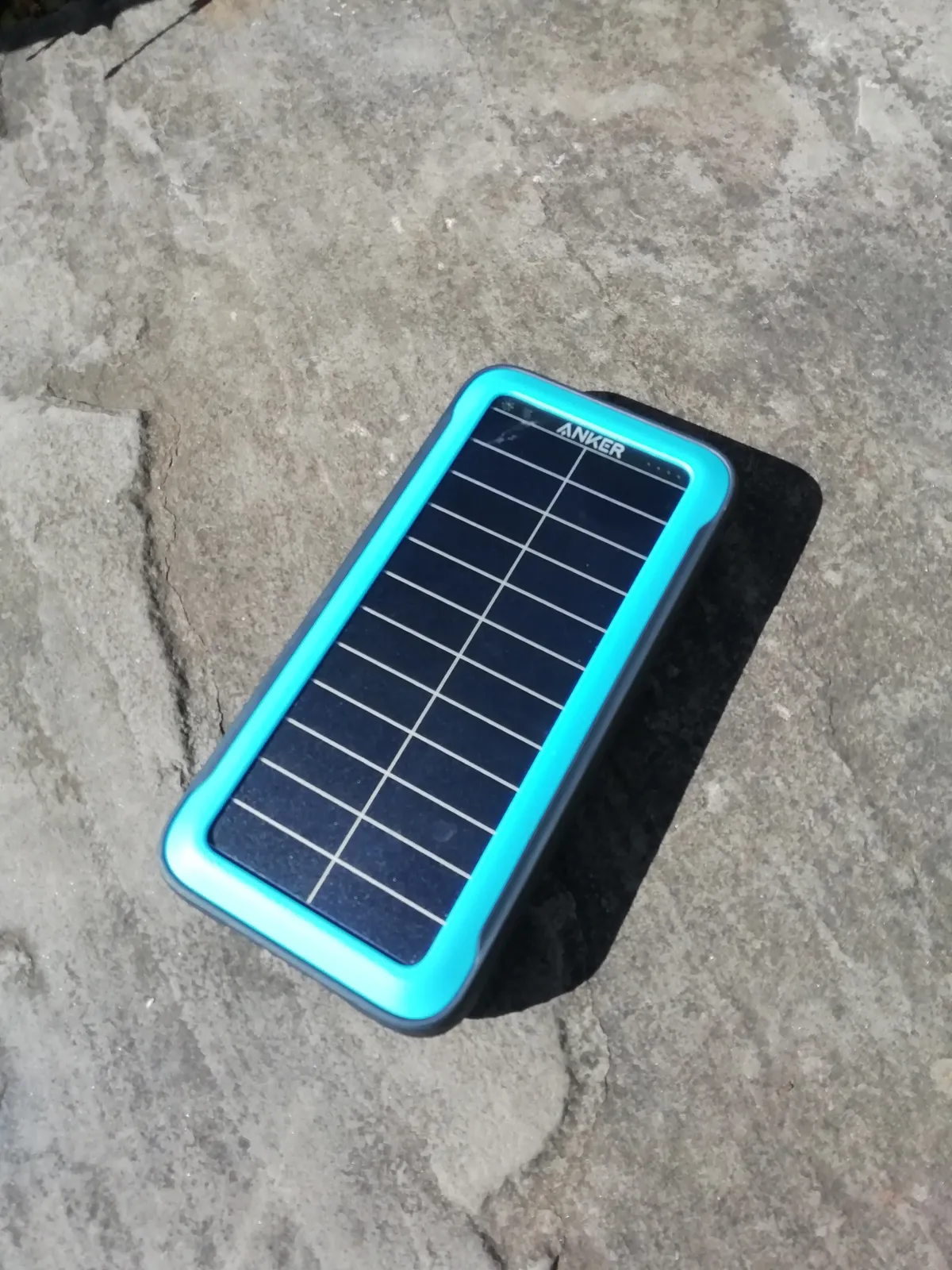
Anker Powercore Solar 20000
This versatile device is a Power Bank that also has a solar panel on one side – plus a decent torch. Its main use is as a store for energy – take it fully charged on a camping trip and it should power multiple devices (via a USB cable) for several days. The solar panel is a useful option but it is not particularly efficient.
I left the Powercore (fully discharged) out in full sun for about 8 hours and it provided only about 30% charge for my phone. It would take several days of sunshine to fully charge this device – and about 7 hours direct from a plug socket.
Interested in power banks? We've tried and tested lots of different models; see our honest reviews in our guide to the best power banks .
Share this article

Editor, BBC Countryfile Magazine
You may also like
Countryfile, best camping showers to take on the road in 2024, rab solar eco 2 sleeping bag review, john craven: green energy, climate change and citizen action – what does the year ahead hold, hill-walking kit guide.

- Terms & Conditions
- Privacy Policy
- Cookies Policy
- Code of conduct
- Manage preferences

8 best solar chargers for camping and backpacking, tried and tested
T he sun is finally making its tentative return, which means garden parties , picnics in the park and – most thrillingly of all – the prospect of harvesting free electricity from the sky using one of the best portable solar panels.
While the heavy-duty solar panels you might install on your roof can help power everything from your washing machine to your portable air conditioner , smaller solar panels are perfect for keeping electronics like laptops , phones and tablets charged up while camping or hiking in the great outdoors.
Coupled with a portable power station, some of the more powerful panels in our list can be used to keep garden sheds, polytunnels or off-grid campsites thrumming with a limited supply of free electricity, even once the sun goes down.
Read more: The complete guide to solar panel home installation
Advances in technology mean today’s solar panels are smaller, lighter and more efficient than ever. Chargers that were once too big to carry can now be folded down to fit inside a travel case or hang from the back of your pack while hiking . So long as you’ve got enough sunlight, the best solar chargers can indefinitely extend the life of your phone, your headphones , and even your laptop .
Solar panels are also used to keep the batteries of cars, motorhomes and boats from going flat when they’re not being used, as most panels will start working automatically as soon as sunlight hits them, meaning you can set them and forget them.
How we tested
We tested these solar panels and chargers last summer, as well as throughout the darker and cloudier days that followed. Solar panels use the sun’s light to produce energy – not heat – so it’s possible to continue using them during the winter if the sky is clear and you can angle them correctly. You’ll still be severely limited by shorter daylight hours and overcast conditions, naturally.
We tested a range of solar chargers for different uses, from large, fold-out models capable of powering multiple devices at once, to portable power banks with convenient built-in solar panels. We trialled them under the changeable weather conditions of south England, as well as while camping and at a festival. These are the ones that really shone.
The best solar chargers for 2024 are:
- Best overall – Goal zero nomad 20 solar panel: £174, Decathlon.co.uk
- Best budget solar panel – Forclaz trek 500 10W: £34.99, Decathlon.co.uk
- Best for camping – Jackery SolarSaga 100W solar panel: £217, Hampshiregenerators.co.uk
- Best for campervans – Ecoflow 220W: £449, Hampshiregenerators.co.uk
- Best fold-out power bank – Addtop solar charger power bank: £33.59, Amazon.co.uk
Goal zero nomad 20 solar panel
The Goal Zero nomad 20 is a flat and highly portable solar charger designed for backpackers and campers who want to travel light but need something more than a basic 5W panel. Half-a-metre wide when unfolded and weighing less than a laptop, it has an adjustable kickstand for aiming it directly towards the sun when placed on the ground. The rugged plastic frame has an attachment point on each corner, so you can strap it to a backpack or secure it firmly in place wherever it needs to be.
We liked that the USB output is on a lightly flexible arm, which helps prevent wear and tear on your charging cables. You can also chain multiple panels together with the included 6ft-long chaining cable to speed up charging.
Buy now £174.99, Decathlon.co.uk
Forclaz solar panel SLR 500 V2 - 10W
The Forclaz solar panel SLR 500 is a 10W solar charger with a single USB port, ideal for keeping battery packs topped up while on the move or camping. A respectable power output places this versatile panel somewhere in the middle of the range, delivering more energy than a small trickle charger but less than a larger and more expensive solar panel.
The dual-panel design packs away neatly into a fabric pouch and can be firmly strapped to a backpack with the help of included carabiners and eight anchor points. A reliable charging solution that straddles the gap between low-and-slow panels and more serious hardware, the Forclaz panel suits casual campers and long-distance walkers.
Buy now £34.99, Decathlon.co.uk
Jackery SolarSaga 100W solar panel
The Jackery SolarSaga 100W solar panel is designed to work with the Jackery power station – which is mainly how we tested it – but it can easily be operated solo thanks to its USB-A and USB-C outputs. The relatively high wattage and variable output of the panel means it’s a lot more suited to recharging a dedicated smaller power bank, which you would then use to charge your devices, rather than plugging your phone or laptop directly into it. That’s good news for anyone who travels light and doesn’t want to lug the heavy Jackery power station around with them.
The foldable panel itself is exceptionally well made, snapping shut magnetically and featuring a comfortable carry handle for safe transport and setup. The kickstand can be adjusted to any angle to get the most efficient performance possible, though the lightweight construction leaves it prone to falling over in windy conditions. Handily, there are reinforced eyelets and loops to secure it. The panel isn’t waterproof either, so we’d advise against leaving it outside the tent overnight.
Buy now £217.00, Hampshiregenerators.co.uk
Ecoflow 220W solar panel
The Ecoflow 220W is a dedicated solar panel that produces roughly ten times the wattage of the next best entry in our list. This does make it less portable, but also way more useful for charging the specialist batteries needed to power small appliances at campsites, off-grid rental lodges, caravans, and for emergency home backup should your electricity ever fail.
The solar panel is bifacial, meaning it’s got a second 155W panel on the reverse side. This allows it to pick up a small amount of bonus current by absorbing some ambient light in bright conditions, which creates a more even power distribution in changeable weather conditions and so less wear on the device it’s charging.
We tested the 220W panel with Ecoflow Delta power station, a 14kg beast of a battery that features four USB-A ports (two fast-charging), two USB-C ports and four three-pin plug sockets. The station can be slow-charged by solar panel, or by mains power in less than two hours.
Buy now £449.00, Hampshiregenerators.co.uk
BioLite solar panel with integrated power pack
This ultra-thin 5W solar panel is an all-in-one solution and, unlike other solar chargers in our list, has an integrated 2,200mAh battery pack embedded on the back. That’s about enough to charge your phone once, which is all you need in an emergency.
It has a simple wire-loop kickstand that can be threaded through a backpack strap, hooked from a tree branch or used to prop the panel up on the ground. Eyelets on the bottom corners also prevent it from sliding out of the sunlight as you walk. We liked the incredibly simple sundial on the corner of the device, which allows you to accurately aim the panel directly into the sunlight for maximum efficiency.
Buy now £76.00, Gooutdoors.co.uk
BigBlue 3 USB ports 28W solar charger
A folding solar charger with 28W output in optimal skies, this four-panel BigBlue solar panel can recharge three low-draw, 5V devices at the same time through its three USB-A ports. Powerful enough to slow-charge tablets and other high-drain mobile devices, this solar charger has a flexible design that’s useful for hanging from your back as you walk, from your tent as you camp, or from a window frame for household power. It comes with carabiners for attaching it to a rucksack or frame.
Buy now £74.99, Amazon.co.uk
Addtop solar charger power bank
This is a 25,000mAh battery pack with a fold out four-panel solar cell, which produces enough photonic juice to trickle-charge the pack’s power reserves over time. These super-portable chargers are limited by physics, that old killjoy, so don’t expect the rinky-dink panels to kick out enough energy to be able to run a laptop or survive entirely off-grid. They’ll charge the battery pack to full given a few days of bright, sunny weather.
Still, if you’re after a rugged outdoor power bank with a built-in LED torch that can top itself up in the background while you’re setting up camp and wrestling bears, this is a convenient and useful little gadget to have in your pack.
Buy now £33.59, Amazon.co.uk
Halfords 10W solar power battery maintainer
If your car battery has a tendency to run dry when left idle for too long, you need a solar-powered car-battery maintainer. Even in the photon-averse British weather, a solar panel affixed to the inside of your windscreen can trickle enough charge into the battery to keep it refreshed and ready to go.
This 10W solar charger can be placed inside your car, but it’s waterproof and durable enough to be positioned outside for better efficiency. It clamps directly to the battery using crocodile clips or can deliver charge via your cigarette lighter if the car’s electrics allow it. One downside is that the basic design means there’s no interface or status light to confirm that any charging is happening, so if want to be absolutely sure it’s working you’ll need to use a multimeter to double check your car battery level.
The power output is rated for charging larger batteries too, such as those found on boats, barges and trucks.
Buy now £29.49, Halfords.com
Solar chargers FAQs
What should i look for when buying a solar charger.
Before buying a solar charger, you should think about the kinds of trips you will be using it for and what you’ll be charging. There are three things worth considering – output capacity, surface area and the flexibility of the panels.
- Output capacity: Solar panels are rated in watts. The higher the number, the more electricity is generated during a given time period, but the larger the panel will be.
- Surface area: The larger the solar panel, the more sunlight it can collect. This means batteries can charge at faster speeds, or more devices can be charged at once. For this reason, a large surface area is a good option for times when the weather conditions are poor or daylight hours are short.
- Semi-flexible or rigid panels: Flexible solar panels are great for those with limited bag space as they can be folded up for easy transport. They are also a great choice as they can be folded out to form a greater surface area than a rigid model.
- Kickstands: Solar chargers need to be aimed directly at the sun to achieve peak efficiency, with even a slight offset having a big impact on how much power they produce. Look for a solar charger with a kickstand that can be adjusted to any angle, not just in increments, so you can get the positioning just right.
How long do solar chargers last?
Solar cells deteriorate over time. While performance varies from model to model, most models are rated to maintain 99 per cent efficiency for upward of three years, with some of the more premium designs claiming to last an impressive 25 years.
Do solar chargers work through a window?
Yes, but the amount of energy harvested by the panel will be greatly reduced, especially if the glass is tinted or has UV light-blocking properties. According to Sol Volatics , a website that provides advice on solar panel installations, the efficiency of a panel can be reduced by up to 50 per cent, depending on the thickness and cleanliness of the glass. So yes, a solar panel left in a car on a sunny day will continue to work, but it’ll charge up a battery far less quickly than when outside in direct sunlight.
What are the best uses for solar chargers?
Portable solar chargers are best used to power small electrical items, such as smartphones and portable battery packs. They can be perfect for topping up the batteries of devices you might take on a camping trip, but generally aren’t much help when it comes to feeding more power-hungry products, such as televisions, portable fridges and kettles.
Some portable solar panels, such as the Ecoflow 220W (£449, Hampshiregenerators.co.uk ) highlighted earlier, cost much more than others, are significantly larger, and therefore will harvest more energy. Such panels can, eventually, fill up an equally large portable battery pack capable of running anything with a domestic three-pin plug, but how quickly the battery charges will depend on weather conditions and how much sunlight the solar panel is exposed to.
Phones and laptops prefer a consistent flow of energy, but the power of output of solar panels varies based on weather conditions and the angle of the sun. Some phones will refuse to charge from a panel that’s fluctuating in output, so it’s always best to use the panel to recharge a portable power bank first, then charge your devices from that.
Will using a solar charger save me money?
A solar charger can technically save you money, though you’d need to recharge your devices a lot just to break even on using a solar charger at home. The power output of portable panels simply isn’t very high – it’s more than enough to charge electronics, but not enough to run appliances or heat tanks of water. Those energy-intensive jobs are where most of your electricity is used, so a portable solar panel will hardly make a dent in your household bills.
What are the alternatives if there is no sunlight?
Obviously, solar panels don’t work without sunlight to power them. If you live somewhere with reduced or no sunlight during the winter months (which includes the UK and parts of North America), you’ll see a dramatic downturn in solar panel energy output when the sun is low in the sky.
To supply electricity in a remote area with little sunlight, you’ll either need a very large battery pack to store up what little solar energy is available, or a fully fuelled diesel generator. The latter is by far the cheapest way of powering remote sites or an entire home, and, to deal with emergencies, they can be set up to kick into action in the event of power loss.
The verdict: Solar chargers
The Goal Zero nomad 2 has everything you might need in a solar charger: high wattage, an abundance of USB ports and a business-like folding design and the leading monocrystalline panel type.
For mains-style power output on demand, the Ecoflow portable power station and 220W panel is highly recommended.
Interested in a better phone to travel with? We’ve rounded up the best phones in 2024
From news to politics, travel to sport, culture to climate – The Independent has a host of free newsletters to suit your interests. To find the stories you want to read, and more, in your inbox, click here .
This article may contain affiliate links that Microsoft and/or the publisher may receive a commission from if you buy a product or service through those links.

Will be opening soon...

Type and hit Enter to search
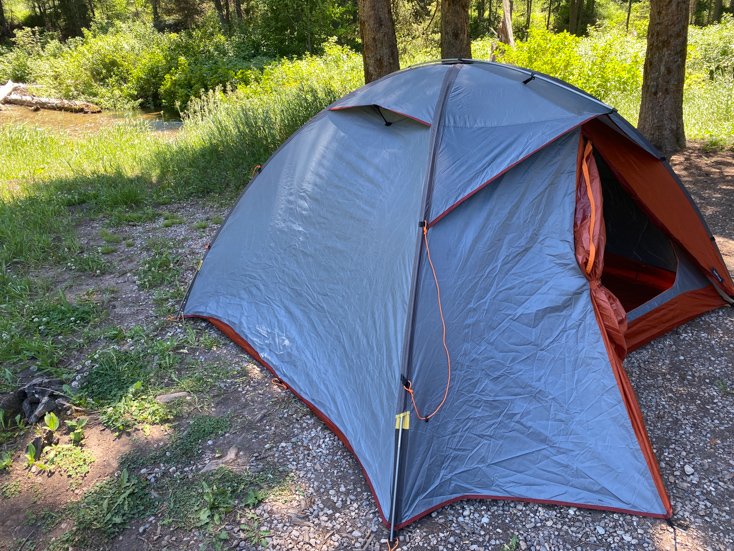
Decathlon Forclaz Trek 500 Tent Review
Some of you may be in the same boat as me where you aren’t backpacking quite as much as in your younger years. You may think a tent is a tent and why not just car camp in the backpacking tent that you already have? In that case, like me, you may also enjoy the Decathlon Forclaz Trek 500 Tent.

Setting up the Decathlon Forclaz Trek 500 starts with inserting a pole into a tent sleeve and then repeating the process with the second pole into the other sleeve. The tent pops up as the pole ends are fit into their bases.
A small pole goes across the top of the tent to help with airflow. And there you go! The tent is ready to roll.
The rainfly is integrated and does not need to be added separately. There is space between the main tent and the rainfly as you would expect for ventilation.
Two of these velcro attachments provide extra venting between the main tent and rainfly.
I am accustomed to exterior tent poles with clips instead of interior poles. I made progress on my push technique instead of using a pull technique (as the later makes the tent poles pull apart). This was especially crucial during tent break down.
I like how the zippers are attached to the tent fabric so they take the fabric with them instead of letting it flap or drag on the ground when being unzipped.
There are thoughtful touches like ties to hold back both the exterior and interior doors.

Roomy for 2 People
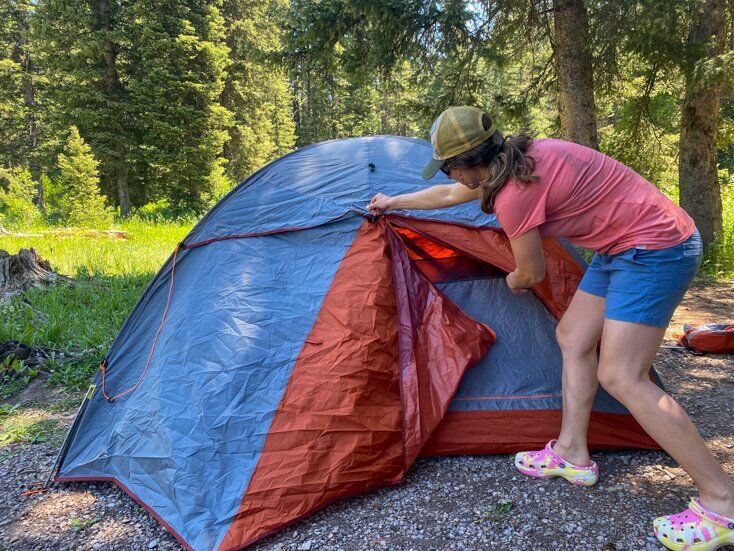
It’s always great to gain a new perspective– especially when it comes to comfort in the great outdoors. It turns out that a 3-person tent is way more comfortable for two people than a 2-person backpacking tent! Plenty of space for two and nice head room when sitting up. Handy for changing clothes.
Extra Features
The integrated drying line is nice.
I love a couple of good tent pockets for my headlamp, phone, and car keys.
When packing up, I appreciated the wide stuff sack with a zipper as opposed to a traditional narrow, deep stuff sack.
Overall Impression

Overall, the Decathlon Forclaz Trek 500 Tent is a cozy, solid, roomy home away from home. It even has some eco features such non-anodized pegs and dyeing 1/2 threads to reduce the impact on the environment. This reduces water consumption and wastewater production.
The Decathlon Forclaz Trek 500 tent is easy to set up, spacious for hanging out, and comes in at a price point of $209 that does not break the bank. Some might even argue that it is light enough for backpacking (7.8 lbs). How light is light enough is debatable in the backpacking world!
Happy camping!
Today's Best Prices

Product prices and availability are accurate as of the date/time indicated and are subject to change. Any price and availability information displayed on Amazon.com at the time of purchase will apply to the purchase of this product.

Related Tents
- MSR Carbon Reflex Ultralight Tent
- Klymit Maxfield 2 Tent
- Kelty Dirt Motel 2 Tent
Share Article

Molly Grove
Molly Grove has sought mountain vistas and quality gear for most of her life. An early love of skiing paired with a high school job at a ski shop in Bend, Oregon laid the foundation for life in the mountains.
No Comment! Be the first one.
Leave a reply cancel reply.
Your email address will not be published. Required fields are marked *

- Visit Our Blog about Russia to know more about Russian sights, history
- Check out our Russian cities and regions guides
- Follow us on Twitter and Facebook to better understand Russia
- Info about getting Russian visa , the main airports , how to rent an apartment
- Our Expert answers your questions about Russia, some tips about sending flowers

Russian regions
- Chelyabinsk oblast
- Khanty-Mansi okrug
- Kurgan oblast
- Sverdlovsk oblast
- Nizhny Tagil
- Tyumen oblast
- Yamalo-Nenets okrug
- Map of Russia
- All cities and regions
- Blog about Russia
- News from Russia
- How to get a visa
- Flights to Russia
- Russian hotels
- Renting apartments
- Russian currency
- FIFA World Cup 2018
- Submit an article
- Flowers to Russia
- Ask our Expert
Yekaterinburg city, Russia
The capital city of Sverdlovsk oblast .
Yekaterinburg - Overview
Yekaterinburg or Ekaterinburg (Sverdlovsk in 1924-1991) is the fourth most populous city in Russia (after Moscow, St. Petersburg, and Novosibirsk), the administrative center of the Ural Federal District and Sverdlovsk Oblast.
This city is one of the country’s largest transport and logistics hubs, as well as an important industrial center. It is unofficially called the “capital of the Urals.”
The population of Yekaterinburg is about 1,493,600 (2022), the area - 468 sq. km.
The phone code - +7 343, the postal codes - 620000-620920.
Ekaterinburg city flag
Ekaterinburg city coat of arms.
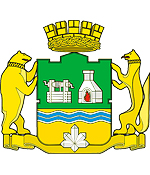
Ekaterinburg city map, Russia
Ekaterinburg city latest news and posts from our blog:.
26 May, 2020 / Unique Color Photos of Yekaterinburg in 1909 .
2 December, 2018 / Yekaterinburg - the view from above .
21 November, 2018 / Abandoned Railway Tunnel in Didino .
4 December, 2017 / Stadiums and Matches of the World Cup 2018 in Russia .
3 January, 2017 / Ekaterinburg, the Capital of the Urals: Then and Now .
More posts..
News, notes and thoughts:
4 April, 2011 / Free travel on new high-speed trains should allay fans' fears about long journey to Ekaterinburg - the most far-flung city on Russia's list of sites for 2018 World Cup. Let's hope the train will not break down in the middle of nowhere.
1 February, 2011 / Today is the 80th anniversary of the birth of Boris Yeltsin, the first president of Russia. President Medvedev today unveiled a monument to Yeltsin in his home city Ekaterinburg. First one in Russia.
History of Yekaterinburg
Foundation of yekaterinburg.
The territory along the Iset River, which served as a convenient transport route from the Ural Mountains deep into Siberia, has long attracted settlers. The oldest of the currently discovered settlements on the territory of present Yekaterinburg was located next to the Palkinsky Stone Tents rock massif and dates back to the 6th millennium BC.
From the 7th-3rd centuries BC, ancient metallurgists who mastered the smelting of copper lived in this settlement. Copper figures of birds, animals, people, arrowheads, various household items were found here. Later they learned how to make iron products. All discovered settlements were destroyed as a result of fires, possibly during raids of the conquerors.
The territory occupied by present Yekaterinburg became part of Russia in the middle of the 17th century. At that time, it had practically no permanent population. The first Russian settlements were founded in the second half of the 17th century. At the beginning of the 18th century, the first ironworks were built here.
In the spring of 1723, by decree of Emperor Peter I, the construction of the largest iron-making plant in Russia began on the banks of the Iset River. Construction began on the initiative of Vasily Tatishchev (a prominent Russian statesman). He was supported by Georg Wilhelm de Gennin (a German-born Russian military officer and engineer), on the initiative of which the fortress plant was named Yekaterinburg in honor of Empress Catherine I (Yekaterina in Russian), the wife of Peter I.
More Historical Facts…
The historic birthday of Yekaterinburg is November 18, 1723. On this day, a test run of the plant equipment was carried out. Its main products included iron, cast iron, and copper. In 1725, the Yekaterinburg Mint began production on the territory of the fortress and became the main producer of copper coins in the Russian Empire. Until 1876, it produced about 80% of the country’s copper coins. In the 1720s, the population of Yekaterinburg was about 4,000 people.
Yekaterinburg - one of the economic centers of the Russian Empire
In the middle of the 18th century, the first ore gold in Russia was discovered in this region, which was the beginning of the gold industry in the country. As a result, Yekaterinburg became the center of a whole system of densely located plants and began to develop as the capital of the mining region, which spread on both sides of the Ural Range.
In 1781, Catherine II granted Yekaterinburg the status of a county town in the Perm Governorate. The population of the town was about 8,000 people. In 1783, the town received a coat of arms depicting an ore mine and a melting furnace, which symbolized its mining and metallurgical industries (similar images are depicted on the current coat of arms and flag of Yekaterinburg).
In 1783, the Great Siberian Road was opened - the main road of the Russian Empire that passed through Yekaterinburg. It served as an impetus for the transformation of Yekaterinburg into a transport hub and a center of trade. Thus, Yekaterinburg, among other towns of the Perm Governorate, became the key town for the development of the boundless and rich Siberia, the “window to Asia”, just as St. Petersburg was the Russian “window to Europe.”
In 1808, the Yekaterinburg plant was closed, and the history of the town entered a new stage related to the development of a large regional center with a diversified economy. At the beginning of the 19th century, the gold mining industry flourished. At the same time, deposits of emeralds, sapphires, aquamarines, diamonds, and other precious, semiprecious, and ornamental stones were discovered in the Urals. Yekaterinburg became one of the world centers for their artistic processing.
After the abolition of serfdom in 1861, the mining industry of the Urals experienced a severe crisis, a number of plants were closed. In 1878, the first railway was constructed across the Urals and connected Yekaterinburg with Perm. In 1888, the Yekaterinburg-Tyumen railway was built, and in 1897 - the railway to Chelyabinsk, which provided access to the Trans-Siberian Railway. Yekaterinburg became a major railway junction, which contributed to the development of the local food industry, especially flour milling. In 1913, the population of Yekaterinburg was about 69,000 people.
Yekaterinburg in the first years of Soviet power
On November 8, 1917, Soviet power was established in Yekaterinburg. On April 30, 1918, the last Russian emperor Nicholas II and his family members with a few servants were transported from Tobolsk to Yekaterinburg. They were placed in the “House of Special Purpose”, the mansion of engineer Nikolai Ipatiev requisitioned for this purpose, and transferred under the supervision and responsibility of the Ural Regional Soviet.
In July 1918, units of the White Siberian army approached Yekaterinburg, under this pretext the leadership of the Ural Regional Soviet decided to shoot the imperial family. On the night of July 16-17, 1918, it was done in the basement of the Ipatiev House.
10 days later, units of the Czechoslovak Legion entered Yekaterinburg. Over the next 12 months, it was under the control of anti-Bolshevik forces. On July 14, 1919, the Red Army reoccupied the city. Soviet authorities and the Yekaterinburg Province with a center in Yekaterinburg were restored. In 1920, the population of the city was about 94,400 people.
The political center of the Urals moved from Perm to Yekaterinburg. In 1923, Yekaterinburg became the administrative center of the vast Ural Oblast, which in size exceeded the territory of the present Ural Federal District of Russia. In 1924, the city council decided to rename the capital of the new region to Sverdlovsk - in honor of Yakov Sverdlov, a Bolshevik party administrator and chairman of the All-Russian Central Executive Committee.
Sverdlovsk - a Soviet industrial giant
During the years of Stalin’s industrialization, Sverdlovsk was turned into a powerful industrial center. The old factories were reconstructed and new large factories were built, including giant machine-building and metal processing plants. In 1933, the construction of the future flagship of Soviet engineering (Uralmash) was completed. The population of Sverdlovsk grew by more than 3 times, and it became one of the fastest growing cities in the USSR.
January 17, 1934, Ural Oblast was divided into three regions - Sverdlovsk Oblast with a center in Sverdlovsk, Chelyabinsk Oblast with a center in Chelyabinsk, and Ob-Irtysh Oblast with a center in Tyumen. By the end of the 1930s, there were 140 industrial enterprises, 25 research institutes, 12 higher educational institutions in Sverdlovsk. In 1939, the population of the city was about 425,500 people.
Along with other Ural cities, Sverdlovsk made a significant contribution to the victory of the USSR in the Second World War. In total, more than 100,000 residents of the city joined the Red Army. 41,772 people didn’t return from the war: 21,397 - killed in battles, 4,778 - died from wounds in hospitals, 15,491 - went missing, 106 - died in prisoner of war camps.
Sverdlovsk became the largest evacuation point, more than 50 large and medium enterprises from the western regions of Russia and Ukraine were evacuated here. During the war years, industrial production in Sverdlovsk grew 7 times.
After the war, this city became the largest center for engineering and metalworking in Russia. During the Cold War, Sverdlovsk, as a key center of the defense industry, was practically closed to foreigners. In 1960, in the sky above the city, Soviet air defense shot down the U-2 spy plane of the US manned by Francis Gary Powers.
On January 23, 1967, a millionth resident was born in the city and Sverdlovsk became one of the first Russian cities with a population of more than 1 million people. In 1979, Sverdlovsk was included in the list of historical cities of Russia.
On October 4, 1988, a serious accident occurred at the Sverdlovsk railway station. The train carrying almost 100 tons of explosives rolled downhill and crashed into a coal freight train. An explosion occurred, aggravated by the proximity of a large warehouse of fuels and lubricants. The funnel at the site of the explosion had a diameter of 40-60 meters and a depth of 8 meters, the shock wave spread 10-15 kilometers. The explosion killed 4 people at the station and injured more than 500 people. About 600 houses were severely damaged.
Yekaterinburg - one of the largest cities of the Russian Federation
On September 4, 1991, the Sverdlovsk City Council of People’s Deputies decided to return the city its original name - Yekaterinburg. The population of the city was about 1,375,000 people. The restrictions on foreign visitors to the city were also lifted, and soon the first consulate general was opened here - the United States of America (in 1994).
The transition to a market economy led to a reduction in production at industrial enterprises, inert giant plant found themselves in a particularly difficult situation. In 1991, the construction of the television tower was stopped. The city was flooded with chaotic small retail trade in temporary pavilions and markets. These years were the heyday of organized crime, Yekaterinburg became one of the “criminal capitals” of Russia. The economic situation began to improve by the end of the 1990s.
In 2000-2003, the Church on Blood in Honour of All Saints Resplendent in the Russian Land was built on the site of the Ipatiev House in Yekaterinburg. In 2008-2009, the Koltsovo Airport was reconstructed. In June 15-17, 2009, SCO (Shanghai Cooperation Organization) and BRIC (Brasilia, Russia, India, China) summits were held in Yekaterinburg.
In 2015, the Presidential Center of Boris Yeltsin, the first president of Russia, was opened in Yekaterinburg. On March 24, 2018, the abandoned unfinished television tower was dismantled. It was the tallest building in the city (almost 240 meters) and became one of the symbols of Yekaterinburg. 4 matches of FIFA World Cup 2018 were played in Yekaterinburg.
Today, Yekaterinburg is the largest center of attraction not only of Sverdlovsk Oblast, but also of the surrounding regions. By some socio-economic indicators, this city ranks third in Russia, after Moscow and St. Petersburg. Along with the development of trade and business, the city lost the status of the country’s largest industrial center.
On the streets of Yekaterinburg
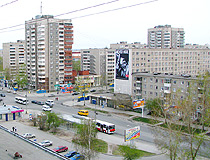
Soviet-era apartment buildings in Yekaterinburg
Author: Alex Kolm
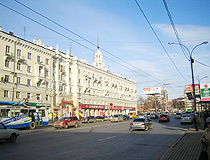
In the central part of Yekaterinburg
Author: Serg Fokin
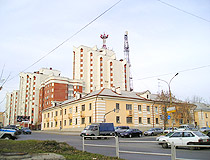
Yekaterinburg street view
Author: Krutikov S.V.
Yekaterinburg - Features
Yekaterinburg is located in the floodplain of the Iset River on the eastern slope of the Middle Urals in Asia, near its border with Europe, about 1,800 km east of Moscow. Since the Ural Mountains are very old, there are no significant hills in the city.
This relief was a favorable condition for the construction of the main transport routes from Central Russia to Siberia (the Siberian Route and the Trans-Siberian Railway) through Yekaterinburg. As a result, it has become one of the most strategically important centers of Russia, which still provides a link between the European and Asian parts of the country.
Yekaterinburg is located in the border zone of temperate continental and continental climates. It is characterized by a sharp variability in weather conditions with well-defined seasons. The Ural Mountains, despite their low height, block the way to the masses of air coming from the west from the European part of Russia.
As a result, the Middle Urals is open to the invasion of cold Arctic air and continental air of the West Siberian Plain. At the same time, warm air masses of the Caspian Sea and the deserts of Central Asia can freely enter this territory from the south.
That is why the city is characterized by sharp temperature fluctuations and the formation of weather anomalies: in winter from severe frosts to thaws and rains, in summer from heat above plus 35 degrees Celsius to frosts. The average temperature in January is minus 12.6 degrees Celsius, in July - plus 19 degrees Celsius.
The city has a rather unfavorable environmental situation due to air pollution. In 2016, Yekaterinburg was included in the list of Russian cities with the worst environmental situation by this indicator. Car emissions account for more than 90% of all pollution.
Yekaterinburg ranks third in Russia (after Moscow and St. Petersburg) in the number of diplomatic missions, while their consular districts extend far beyond Sverdlovsk Oblast, and serve other regions of the Urals, Siberia, and the Volga region.
In terms of economy, Yekaterinburg also ranks third in the country. It is one of the largest financial and business centers of Russia. The main branches of production: metallurgical production and metalworking, food production, production of electrical equipment, electronic and optical equipment, production of vehicles, production of machinery and equipment, chemical production.
Almost all types of urban public transport are presented in Yekaterinburg: buses, trolleybuses, trams, subways, taxis. Yekaterinburg is the third largest transportation hub in Russia: 6 federal highways, 7 main railway lines, as well as Koltsovo International Airport, one of the country’s largest airports. The location of Yekaterinburg in the central part of the region allows you to get from it to any major city of the Urals in 7-10 hours.
Yekaterinburg has an extensive scientific and technical potential, it is one of the largest scientific centers in Russia. The Presidium and about 20 institutes of the Ural Branch of the Russian Academy of Sciences, 66 research institutes, and about 30 universities are located here.
This city is a relatively large tourist center. A significant part of tourists visit it to honor the memory of the last Russian emperor and his family killed by the Bolsheviks in the basement of the Ipatiev House in 1918.
There are about 50 different museums in Yekaterinburg. One of the world’s largest collections of constructivist architectural monuments has been preserved here. In total, there are over 600 historical and cultural monuments in the city, of which 43 are objects of federal significance. The City Day of Yekaterinburg is celebrated on the third Saturday of August.
Interesting facts about Yekaterinburg
- It was founded by the decree of the first Russian Emperor Peter I and the last Russian Emperor Nicholas II was shot here;
- In 1820, the roof of the UK Parliament building in London was made of roofing iron produced in Yekaterinburg;
- Ural steel was used in the construction of the Eiffel Tower in Paris;
- Ural copper was used in the construction of the Statue of Liberty in New York;
- During the Second World War, Sverdlovsk was the center of broadcasting in the USSR;
- Equipment for the world’s deepest borehole (Kola Superdeep Borehole, 12,262 meters) was produced in Yekaterinburg;
- Boris Yeltsin, the first president of Russia, began his political career in Yekaterinburg;
- Minor planet #27736 Yekaterinburg, discovered by the Belgian astronomer Eric Elst on September 22, 1990, was named in honor of this city;
- Two most northern skyscrapers in the world are located in Yekaterinburg: the Iset residential tower (209 m) and the Vysotsky business center (188 m), they are the tallest buildings throughout Russia east of Moscow.
Pictures of Yekaterinburg
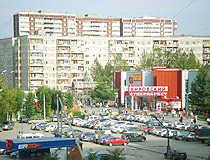
Yekaterinburg city view
Author: Andrey Zagaynov
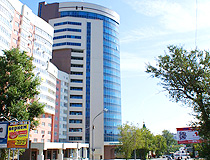
Modern architecture in Yekaterinburg
Author: Yury Baranov
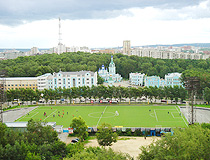
The territory of the central stadium of Yekaterinburg before reconstruction
Author: Sergey Likhota
Main Attractions of Yekaterinburg
Sevastyanov House - a palace of the first quarter of the 19th century built in the architectural styles of pseudo-Gothic, Neo-Baroque, and Moorish traditions and painted in green, white, and red tones. Today, it is the most beautiful building in Yekaterinburg and one of its symbols. The house stands on the promenade of the Iset River, very close to the city dam. Lenina Avenue, 35.
“Plotinka” - the dam of the city pond on the Iset River built in the 18th century. From an architectural point of view, it is an ordinary bridge. However, it is of particular importance for the residents of Yekaterinburg since the construction of the entire city started from this place. Today, this is the main place for festivities in Yekaterinburg. Lenina Avenue.
Observation Deck of the Business Center “Vysotsky” - an open-air observation deck on the 52nd floor at an altitude of 168 meters. From here you can enjoy the views of all of Yekaterinburg. On the second and third floors of this skyscraper there is the memorial museum of Vladimir Vysotsky - a singer, songwriter, and actor who had an immense effect on Soviet culture. Malysheva Street, 51.
Vaynera Street - the central avenue of Yekaterinburg, the so-called “Ural Arbat”. One of its parts from Kuibysheva Street to Lenina Avenue is a pedestrian street. This is one of the oldest streets in Yekaterinburg laid in the middle of the 18th century. Along it, you can see merchant mansions, shops, administrative buildings, most of which were built in the late 19th and first half of the 20th centuries.
Rastorguev-Kharitonov Palace (1794-1824) - one of the most valuable architectural manor and park ensembles in Yekaterinburg, an architectural monument of federal significance built in the classical style and located in the city center. Karla Libknekhta Street, 44.
Church of the Ascension (1792-1818) - one of the oldest churches in Yekaterinburg located next to the Rastorguev-Kharitonov Palace. This beautiful building combines the features of baroque, pseudo-Russian style, and classicism. Klary Tsetkin Street, 11.
Yeltsin Center - a cultural and educational center dedicated to the contemporary history of Russia, as well as the personality of its first president, Boris Yeltsin. The museum dedicated to his life is one of the best museums in Russia. Borisa Yeltsina Street, 3.
Yekaterinburg Museum of Fine Arts - the largest art museum in the Urals housed in two buildings. This museum is best known for its unique collection of Kasli art castings and the world-famous Kasli cast iron pavilion - a participant in the 1900 Paris World’s Fair.
The following collections can also be found here: Russian paintings of the 18th - early 20th centuries, Russian avant-garde of 1910-1920, Russian porcelain and glass of the 18th - 20th centuries, Russian icon painting of the 16th-19th centuries, Western European art of the 14th-19th centuries, stone-carving and jewelry art of the Urals, Zlatoust decorated weapons and steel engraving. Voevodina Street, 5; Vaynera Street, 11.
Museum of the History of Stone-Cutting and Jewelry Art . A unique collection of this museum consists of gem minerals, works of jewelers and stone-cutters of the Urals, and products created at the Ural lapidary factory. The museum has Malachite and Bazhov halls, the Emerald Room, and several exhibition galleries where visitors can see works made of colored stone and metal created by local artists. Lenina Avenue, 37.
Sverdlovsk Regional Museum of Local Lore . At first, its collection consisted of four departments: mineralogical, botanical, zoological, and paleontological. Later, numismatic, ethnographic, and anthropological sections were added. Today, there are more than 700 thousand exhibits here. Lenina Avenue, 69/10.
Museum of the History of Yekaterinburg . This museum occupies a historic building of the 19th century. In addition to the main exhibition, you can see the wax figures of Peter the Great, Catherine II, Nicholas II, the Ural manufacturers Demidov, and the founders of Yekaterinburg.
Old Railway Station of Yekaterinburg - one of the most beautiful and picturesque buildings in the city built in 1878. In 2003, after a large-scale reconstruction, the Museum of the History of Science and Technology of the Sverdlovsk Railway was opened here. Vokzal’naya Ulitsa, 14.
Yekaterinburg Circus . Visible from a lot of points of the city, the building of the Yekaterinburg Circus is known for its amazing dome consisting of trellised openwork semi-arches, which is not typical for circuses in Russia. 8 Marta Street, 43.
White Tower (1929-1931) - a former water tower 29 meters high located at a certain distance from the center of Yekaterinburg, an architectural monument of Constructivism. Today, it is used as a cultural site. Bakinskikh Komissarov Street, 2?.
Keyboard Monument - a contemporary art object made on a scale of 30:1 in 2005. This 16x4 meter concrete keyboard consists of 104 keys spaced 15 cm apart. From here the famous tourist route “Red Line” begins (a self-guided tour of the historic city center). The monument is located on the embankment of the Iset River next to the House of the Merchant Chuvildin (Gorkogo Street, 14A).
Ekaterinburg city of Russia photos
Places of interest in yekaterinburg.
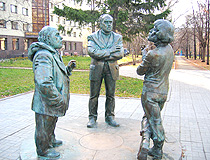
Sculpture of talking townspeople in Yekaterinburg
Author: Pichugin Mikhail
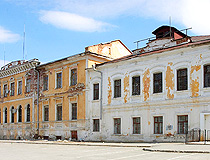
Old buildings in Yekaterinburg
Author: Andrew Golovin
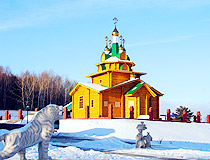
Wooden Church of the Holy Martyr Arkady in Yekaterinburg
Author: Kutenyov Vladimir
Street transport of Yekaterinburg
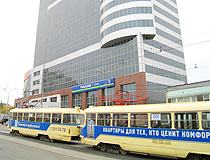
Tram in Yekaterinburg
Author: Andrey Permyakov
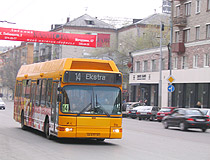
Bus in Yekaterinburg
Author: Per Heitmann
The questions of our visitors
All 5 questions
The comments of our visitors
- Currently 3.06/5
Rating: 3.1 /5 (288 votes cast)

IMAGES
VIDEO
COMMENTS
FORCLAZ. SOLAR PANEL SLR 500 V2 - 10W. 4. 95 reviews. Charge your external charger with the sun's rays during mountain treks, achieving total energy independence. This solar panel is lightweight, easy to carry, and compact in design. ID 8788789. £34.99. Add to basket.
How to charge your devices outdoors with a solar panel? Read our review of the Forclaz 10w portable solar charger, a handy gadget for camping and hiking.
#Decathlon #SolarPanel #SolarChargerLooking to stop procrastinating? Try this book 🔍 https://www.amazon.com/dp/B01CXBRSVM0:00 Introduction0:23 Unboxing and ...
Become completely energy independent on your treks, whether walking or bivouacking, thanks to this lightweight, easy to transport solar panel that doesn't take up much space.
USB Solar Panel - 10W - SLR500. Solar panels designed to charge your external charger using the sun's rays during your mountain treks. 1 standard USB ports compatible with all USB Type A cables. Due to the variable power of the sun, use with a smartphone is not advised if the panel is set up on a backpack or the sun is not steady.
These are the ones that really shone. Best overall - Goal zero nomad 20 solar panel: £174, Decathlon.co.uk. Best budget solar panel - Forclaz trek 500 10W: £34.99, Decathlon.co.uk. Best for ...
FORCLAZ. USB Solar Panel - 15W - SLR900 V2. 4.3. 114 reviews. Charge your electronic devices while trekking with this compact and lightweight solar panel. Generate your own power and be fully autonomous during your hikes or when bivouacking. ID 8788791. £54.99. Add to basket. Home & store delivery. Available. Pick up today at Decathlon.
Power : 10W (max) solar panel compatible with USB appliances. Battery life : 100% self-sufficient thanks to the solar cells. Durability : Folding panel and textile cover that protects the cells. Versatility : 1 USB port and snap shackles to hook it to a bag or tent. Compact design : Easy to pack in a bag when folded.
Forclaz trek 500 10W: £39.99, Decathlon 2021-07-29 - Best: For hiking. Power: 10W. Weight: 285g. Size folded: 290mm x 180mm x 18mm. Size unfolded: 350mm x 290mm x 13mm. Connections: 1 x USB-A. Decathlon's Trek 500 is a 10W solar charger with a single USB port, ideal for keeping battery packs topped up while on the. move or camping.
Testing a portable solar panel..You'll never know when you need it! Be prepared!Need a multimeter? ..check this https://kaiweets.com/products/kaiweets-st600y...
More at Santos Creative Network:https://santoscreativenetwork.wordpress.com/For Business Inquires Please contact:[email protected] Equipment ...
The WT TREK 500 and 900 models (ref: 8560563 & 8560564) work with any type of microUSB cable. The ONCHANNEL 510 and 710 models (ref: 8335339 and 8335340) are no longer sold and have specific chargers. In case of loss or failure of the charger or a cable, contact our support team from the link at the bottom of the page "access the form".
This reduces water consumption and wastewater production. The Decathlon Forclaz Trek 500 tent is easy to set up, spacious for hanging out, and comes in at a price point of $209 that does not break the bank. Some might even argue that it is light enough for backpacking (7.8 lbs). How light is light enough is debatable in the backpacking world!
Trek500 - 200 Lumens - Rechargeable USB. La lampe frontale TREK500 de FORCLAZ se destine au trek et à l'outdoor montagnard - en mode déplacement. En d'autres termes, elle se recharge, ne craint pas l'humidité et encore moins les chocs. Plus de craintes de randonner la nuit, sur sentiers techniques. Fonctionne aussi sur piles.
Sverdlovsk Oblast - Overview. Sverdlovsk Oblast is a federal subject of Russia, the largest region of the Urals, located on the border between Europe and Asia in the Urals Federal District. Yekaterinburg is the capital city of the region. The population of Sverdlovsk Oblast is about 4,264,300 (2022), the area - 194,307 sq. km.
I have used this panel for several backpacking trips and different tests in full sun and not ideal sunny conditions. I was sceptical of this panel in the beg...
Ekaterinburg Sverdlovsk oblast - Russia. Ekaterinburg is the most important city of the Urals. It is an administrative, transport, commercial, trading, scientific and cultural centre. Besides, it is the regional centre of Sverdlovsk Region. Ekaterinburg borders with Khantia-Mansia Okrug on the North, Tyumen Region on the South-East, Kurgan and Chelyabinsk Regions on the South, perm Region on ...
News, notes and thoughts: 4 April, 2011 / Free travel on new high-speed trains should allay fans' fears about long journey to Ekaterinburg - the most far-flung city on Russia's list of sites for 2018 World Cup. Let's hope the train will not break down in the middle of nowhere. 1 February, 2011 / Today is the 80th anniversary of the birth of Boris Yeltsin, the first president of Russia.
Teste e Review do painel solar da Decathlon - Forclaz Trek 500 de 15w.Bom para quando falha a energia e precisamos de carregar os nossos equipamentos eletrón...
14. Visit the Old Water Tower. Source: Photo by Wikimedia Commons user Dom kobb used under CC BY-SA 3.0. The old water tower is one of Yekaterinburg's oldest structures dating back to the 1800s and stands as a monument of industrial architecture. It is one of the city's endearing symbols.